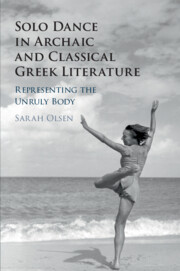Book contents
- Solo Dance in Archaic and Classical Greek Literature
- Solo Dance in Archaic and Classical Greek Literature
- Copyright page
- Dedication
- Contents
- Figures
- Acknowledgments
- Notes on Texts, Abbreviations, and Style
- Introduction
- Chapter 1 The Fantastic Phaeacians
- Chapter 2 Io’s Dance
- Chapter 3 Dance at Work
- Chapter 4 Dance and Dissonance
- Chapter 5 Staging Madwomen
- Chapter 6 Agency, Narrative, and the Dancing Girl
- Chapter 7 Dance History
- Conclusion
- Bibliography
- Index Locorum
- General Index
Conclusion
Reading Dance with Lucian
Published online by Cambridge University Press: 30 November 2020
- Solo Dance in Archaic and Classical Greek Literature
- Solo Dance in Archaic and Classical Greek Literature
- Copyright page
- Dedication
- Contents
- Figures
- Acknowledgments
- Notes on Texts, Abbreviations, and Style
- Introduction
- Chapter 1 The Fantastic Phaeacians
- Chapter 2 Io’s Dance
- Chapter 3 Dance at Work
- Chapter 4 Dance and Dissonance
- Chapter 5 Staging Madwomen
- Chapter 6 Agency, Narrative, and the Dancing Girl
- Chapter 7 Dance History
- Conclusion
- Bibliography
- Index Locorum
- General Index
Summary
The Conclusion draws connections between the Archaic and Classical discourse outlined in this book and the representation of dance, especially pantomime, in the Roman Imperial period. It focuses on a set of key passages in Lucian’s treatise On the Dance, suggesting that by reading dance with Lucian, we can further refine our perspective on the complex interplay between literature, culture, and the potential of the dancing body. I choose to conclude with Lucian in part because his character Lycinus offers an illuminating model for the creative, subversive, and provocative reading of dance. I show that Lycinus uses familiar forms in new ways and rescripts stories about dance encoded within earlier literature, yet in doing so, he also continues a tradition of using the description of solo dance to foreground generic exploration and experimentation – of bringing the unruly body into contact with the workings of a literary text. Reading dance with Lucian and Lycinus thus reveals how the collision of dance and literature bears fruit across diverse creative and cultural contexts.
- Type
- Chapter
- Information
- Solo Dance in Archaic and Classical Greek LiteratureRepresenting the Unruly Body, pp. 200 - 209Publisher: Cambridge University PressPrint publication year: 2020



